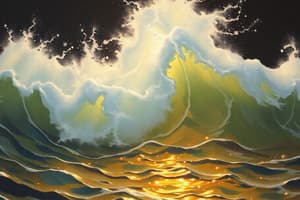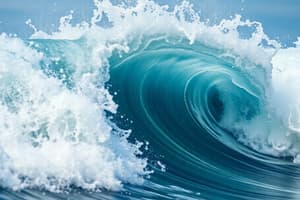Podcast
Questions and Answers
Match the following terms with their descriptions regarding wave energy transfer:
Match the following terms with their descriptions regarding wave energy transfer:
Transverse waves = Waves where particle motion is perpendicular to wave direction Longitudinal waves = Waves where particle motion is parallel to wave direction Amplitude = The height of the wave from the rest position Frequency = The number of waves that pass a point in a given time
Match the following aspects of waves with their effects on energy transfer:
Match the following aspects of waves with their effects on energy transfer:
Wavelength = Determines the energy of the wave Speed = How fast the wave travels through a medium Reflection = Bouncing of waves off surfaces Refraction = Change of direction when entering a different medium
Match the following scenarios with their related wave phenomena:
Match the following scenarios with their related wave phenomena:
A guitar string vibrating = Creation of transverse waves A slinky being compressed = Creation of longitudinal waves Echoes from a wall = Reflected sound waves Light bending through water = Refracted light waves
Which type of wave involves the movement of particles in the same direction as the wave's energy transfer?
Which type of wave involves the movement of particles in the same direction as the wave's energy transfer?
Transverse waves transfer energy by compressing and rarefying the medium.
Transverse waves transfer energy by compressing and rarefying the medium.
What is the primary difference in particle movement between transverse and longitudinal waves?
What is the primary difference in particle movement between transverse and longitudinal waves?
In a longitudinal wave, areas of high pressure are known as __________.
In a longitudinal wave, areas of high pressure are known as __________.
Match the following wave types to their characteristics:
Match the following wave types to their characteristics:
Flashcards are hidden until you start studying
Study Notes
Wave Energy Transfer
- Wave energy transfer is the process by which energy is transported through a medium or space.
- Transverse waves involve the movement of particles perpendicular to the direction of energy transfer.
- Longitudinal waves involve the movement of particles parallel to the direction of energy transfer.
- Compressions are areas of high pressure in longitudinal waves.
- Rarefactions are areas of low pressure in longitudinal waves.
Wave Types and Characteristics
- Transverse waves have crests and troughs.
- Longitudinal waves have compressions and rarefactions.
- Surface waves are a combination of transverse and longitudinal waves.
- Electromagnetic waves are transverse waves that do not require a medium to travel.
Factors Influencing Wave Energy Transfer
- Wave amplitude affects the energy transferred.
- Wave frequency affects the energy transferred.
- Wave speed affects the energy transferred.
- Wave wavelength affects the energy transferred.
- Medium properties affect the energy transferred.
Wave Phenomena
- Refraction is the bending of waves as they pass from one medium to another.
- Diffraction is the spreading of waves as they pass through an opening or around an obstacle.
- Interference is the superposition of waves, resulting in constructive or destructive interference patterns.
- Reflection is the bouncing back of waves from a surface.
Wave Energy Transfer
- Transverse Waves: Energy transfer perpendicular to particle motion
- Longitudinal Waves: Energy transfer parallel to particle motion
- Wave Amplitude: Determines the amount of energy transferred. Larger amplitude equals more energy.
- Wave Frequency: Higher frequency waves transfer more energy per unit time.
- Wave Speed: Faster waves carry energy over a larger distance in a given time.
- Wave Medium: Properties of the medium, such as density and elasticity, affect wave speed and energy transfer.
- Wave Interference: Constructive interference increases energy transfer, destructive interference decreases energy transfer.
- Wave Diffraction: Bending of waves around obstacles; affects energy distribution.
Types of Waves
- Surface Waves: Occur at the interface of two mediums, like water and air. Often a combination of transverse and longitudinal movement.
- Sound Waves: Longitudinal waves that require a medium to travel.
- Electromagnetic Waves: Transverse waves that can travel through a vacuum. Examples include light and radio waves.
- Seismic Waves: Generated by earthquakes, can be both longitudinal (P-waves) and transverse (S-waves).
Wave Phenomena
- Reflection: Waves bounce back from a surface, changing direction but maintaining energy.
- Refraction: Waves bend as they pass from one medium to another, due to changes in speed.
- Diffraction: Bending of waves around obstacles, causing a spreading of energy.
Particle Movement
- Transverse Waves: Particles move perpendicular to the direction of energy transfer. Think of a ripple on a pond.
- Longitudinal Waves: Particles move parallel to the direction of energy transfer. Think of a spring being compressed and stretched.
Wave Characteristics
- Compressions: Areas of high pressure in longitudinal waves.
- Rarefactions: Areas of low pressure in longitudinal waves.
Studying That Suits You
Use AI to generate personalized quizzes and flashcards to suit your learning preferences.




